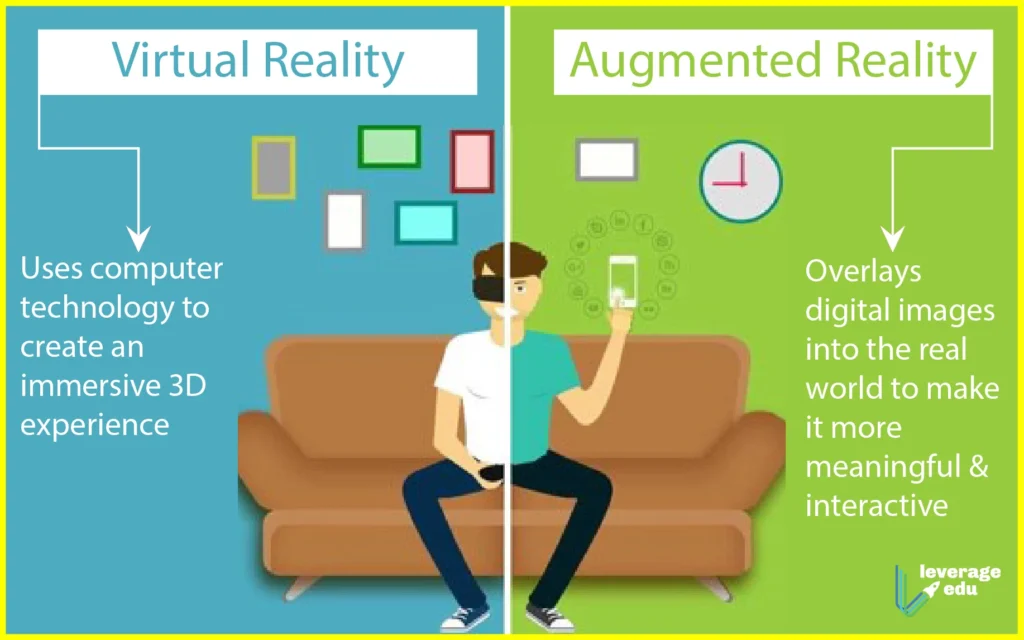Augmented Reality (AR) and Virtual Reality (VR) are two distinct technologies that are often confused with each other. The main difference between the two lies in how they integrate digital information with the real world. AR enhances the real world with digital elements, while VR creates a completely immersive, digital environment. Understanding the nuances between these two technologies is essential for anyone interested in the future of digital experiences.
When comparing Augmented Reality Vs. Virtual Reality, it’s important to note that AR overlays digital information onto the real world, enhancing the user’s perception of their surroundings. On the other hand, VR creates a simulated environment that completely replaces the real world, allowing users to interact with and experience a completely digital world. This distinction is crucial in understanding the different applications and potential uses for each technology. While AR can be used for enhancing real-world tasks such as navigation and education, VR is often used for immersive gaming and training simulations.
What is Augmented Reality?
Augmented Reality (AR) is a technology that superimposes digital information such as images, videos, or 3D models onto the real world environment. This is usually done through a device such as a smartphone, tablet, or AR glasses, which uses the device’s camera and sensors to overlay the digital content onto the user’s view of the real world. AR enhances the user’s perception of the real world by adding virtual elements, and it can be used for various purposes such as gaming, education, navigation, and training.
How Does Augmented Reality Work?
AR works by using the device’s camera to capture the user’s view of the real world, and then overlaying digital content onto this view in real time. The device’s sensors and software track the user’s movements and adjust the position and orientation of the digital content accordingly, creating the illusion that the virtual objects are part of the real world. This seamless integration of virtual and real elements allows users to interact with and manipulate the digital content as if it were physically present in their environment.
What is Virtual Reality?
Virtual Reality (VR) is a technology that immerses users in a completely digital environment, often through the use of a VR headset or goggles. VR creates a simulated reality that can be entirely fictional or based on real-world environments, and users can interact with this digital world through specialized controllers or gestures. VR technology aims to completely replace the user’s real-world environment with a virtual one, providing a highly immersive and interactive experience.
How Does Virtual Reality Work?
VR works by presenting users with a computer-generated 3D environment that they can explore and interact with. The VR headset or goggles display this virtual world in stereoscopic 3D, creating a sense of depth and presence. The user’s movements and interactions are tracked by sensors, which are then translated into the virtual environment, allowing users to navigate and manipulate objects within the digital space. This creates the illusion of being completely immersed in a different reality, separate from the real world.
Key Differences Between AR and VR
One of the key differences between AR and VR is their approach to the real world. AR enhances the real world by overlaying digital content onto it, while VR aims to replace the real world with a completely virtual environment. This means that AR still allows users to interact with their real-world surroundings, while VR isolates users from the real world and immerses them in a digital environment.
Applications of Augmented Reality
AR has a wide range of applications across various industries. In the gaming industry, AR games such as Pokémon Go have become incredibly popular, blending virtual creatures and objects with the real world. In the retail sector, AR can be used to provide virtual try-on experiences for clothing and accessories. AR also has applications in education, healthcare, architecture, and maintenance and repair, allowing users to access valuable information and guidance overlaid onto their real-world environment.
Applications of Virtual Reality
VR is also widely used across different fields. In the entertainment industry, VR provides immersive experiences for gaming, movies, and virtual theme park rides. VR is also used for training and simulation purposes, allowing users to practice skills and scenarios in a safe and controlled virtual environment. In the healthcare sector, VR can be used for pain management, therapy, and medical training. Additionally, VR has applications in architecture and design, allowing users to explore and interact with virtual prototypes of buildings and products.
The Future of AR and VR
Both AR and VR have the potential to greatly impact the way we interact with technology and the world around us. As these technologies continue to evolve, we can expect to see even more innovative applications and advancements, from improved user interfaces to more realistic simulations. With the ongoing development of AR glasses, VR headsets, and related hardware, the future holds exciting possibilities for both AR and VR in entertainment, education, healthcare, and various other industries.
| Augmented Reality | Virtual Reality | |
|---|---|---|
| Definition | Augments digital information onto the real world | Immerses users in a completely virtual environment |
| Interaction with Real World | Interacts with the real world | No interaction with the real world |
| Devices | Smartphones, AR glasses | VR headsets |
| Examples | Pokémon Go, Snapchat filters | Oculus Rift, HTC Vive |
Augmented Reality (AR) and Virtual Reality (VR) are two distinct technologies that offer different experiences to users. AR overlays digital information onto the real world, allowing interaction with the environment, while VR immerses users in a completely virtual environment with no interaction with the real world. Understanding the differences between AR and VR can help in choosing the right technology for specific applications.



